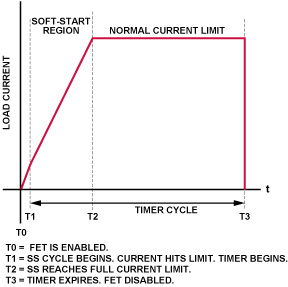Hot-swap controllers are circuits that allow electronic modules to be safely inserted or removed from active backplanes. The controllers manage the initial current to the newly inserted circuit, and prevent the flow of inrush currents that can damage the electronic components, or cause equipment malfunction.
Limiting the high transient currents makes it possible to safely plug in or unplug electronic modules, such as power supplies, into live circuits without damaging the circuit, or powering down the equipment.
Inrush Current when hot-swapping
When a PCB is inserted into live equipment, high inrush currents will flow in order to charge the bypass capacitors. Excessive inrush currents may lead to immediate damage, deterioration of the components, and damaged connectors due to sparking. Further, the inrush currents cause drooping supply voltage levels which may reset or disrupt other modules on the backplane.
A hot-swap controller circuit is therefore required to manage the startup current and control the application of power to the devices during the plugging-in and the unplugging actions. The controller manages the current by providing the desired and safe drive for the MOSFET switch supplying the load. This controls the turn-on voltage slew-rate and therefore protects the circuit against overcurrent conditions.
Typical hot-swap controllers integrate other functions such as acting like an electronics circuit breaker.
A typical hot-swap controller circuit includes
- The Hot-swap microcontroller IC
- N-Channel MOSFET switch
- A current sense resistor
- A timing capacitor
How a Hot-swap controllers works
When a hot-swap board is inserted into a live backplane, the controller ramps up the supply to the board‘s bypass capacitors. This limits the inrush current and avoids malfunctions such as component damage, systems resets and backplane supply glitches.

Hot-Swap contollers Soft-start effect (Image: http://www.analog.com)
At initial startup, the controller utilizes the foldback current limit technique to control the inrush current. The current-sense amplifier monitors and amplifies the voltage drop across the sense-resistor and compares this to a variable or fixed reference voltage. The difference is then used to determine the gate control voltage, which can limit and keep the inrush current below a preset maximum.
Once the hot-swap startup phase is complete, the internal comparator provides an active current-limit protection against overcurrent or short circuit faults. And this allows the load to be quickly disconnected from the power input whenever a fault condition exists.
To keep the MOSFET in the safe operating area (SOA), it is important to select a MOSFET that can handle the power requirements of the load. The reduced slew rate is also an advantage, since it lowers the di/dt rate. However, one should also limit the time the FET conducts the maximum current and use a heat sink to dissipate excess heat.
Typical features of hot-swap controllers
- Control the inrush current
- isolating faults
- overcurrent protection (OCP)
- output-power status reporting
- distinguish load transients from faults
There are different kinds of hot-swap controllers categorized by type, maximum supply voltage or current, packaging, number of outputs, and functionalities.
Dual-channel hot-swap controllers
Dual hot-swap controllers are used to manage two power paths and control two or three different voltages. The two channels can be configured to rise or fall separately or simultaneously. In high current applications the dual channels can be configured to provide two parallel power paths.
Applications for Hot Swap Controllers
The hot-swap controllers are used in high-availability systems designed for near-zero downtime. The controllers are useful when maintaining the critical equipment, replacing faulty parts, or carrying out upgrades while the equipment is still running.
Some of the equipment includes;
- Computer Systems and Servers,
- Communications infrastructure,
- Distributed power systems,
- Redundant Power Supplies,
- Storage systems.